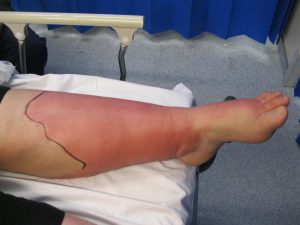
Nội dung bài viết / Table of Contents
This post is also available in: Tiếng Việt (Vietnamese)

Cellulitis manifests as a swollen, red area of skin that you may feel hot and tender. It seems to spread rapidly to other parts of the body. Cellulitis isn’t usually spread from person to person.
Skin on lower legs is considered as most commonly affected, although cellulitis can occur anywhere on your body or face. Cellulitis might influence only your skin’s surface. Or it might also affect tissues underlying your skin and can spread to your lymph nodes and bloodstream.
If you are not treated, the spreading infection can rapidly turn life-threatening. It’s important to seek immediate medical attention if cellulitis symptoms occur.
Cellulitis is a relatively common infection, affecting all racial and ethnic groups. Individuals older than 45 years have a higher incidence of cellulitis.
However, it can be managed by reducing your risk factors. Please discuss with your doctor for further information.
There are a number of signs and symptoms of cellulitis. Feasible signs and symptoms of cellulitis, which usually happens on one side of the body, include:
Early diagnosis and treatment can stop this condition from worsening and prevent another medical emergency, so talk to your doctor as soon as possible to prevent this serious condition.
If you have any signs or symptoms listed above or have any questions, please consulting with your doctor. Everyone’s body acts differently. It is always best to discuss with your doctor what is best for your situation.
Cellulitis is a condition occurs when bacteria, most commonly streptococcus and staphylococcus, enter through a crack or break in your skin. The incidence of a more serious staphylococcus infection called methicillin-resistant Staphylococcus aureus (MRSA) is currently increasing.
Though cellulitis can occur anywhere on your body, the most common location is the lower leg. Bacteria is most likely to enter disrupted areas of skin, such as where you have had recent surgery, cuts, puncture wounds, an ulcer, athlete’s foot or dermatitis.
Certain types of insect or spider bites also can transmit the bacteria that start the infection. Bacteria can also enter through areas of dry, flaky skin or swollen skin.
You may have higher risks for this condition if you are experiencing these following conditions:
Injury
Any cut, fracture, burn or scrape gives bacteria an entry point.
Weakened immune system
Conditions that weaken your immune system, such as diabetes, leukemia and HIV/AIDS, leave you more susceptible to infections. Certain medications, such as corticosteroids, also can weaken your immune system.
Skin conditions
Skin disorders, such as eczema, athlete’s foot, chickenpox and shingles, are able to cause breaks in the skin and give bacteria an entry point.
Chronic swelling of your arms or legs (lymphedema)
Swollen tissue may crack, leaving your skin vulnerable to bacterial infection.
History of cellulitis
People who previously had cellulitis, especially of the lower leg, may be more prone to develop it again.
Intravenous drug use
People who inject illegal drugs have a higher risk of developing cellulitis.
Obesity
Being overweight or obese increases your risk of developing cellulitis and having recurring episodes.
The information provided is not a substitute for any medical advice. ALWAYS consult with your doctor for more information.
If your doctor suspects that you may experience this condition, a physical examination will be performed and some tests will be also recommended by your doctor. These tests may include:
Cellulitis treatment usually includes a prescription oral antibiotic. Within three days of starting an antibiotic, let your doctor know whether the infection is responding to treatment. You’ll need to take the antibiotic for as long as your doctor directs, usually five to 10 days but possibly as long as 14 days.
In most cases, signs and symptoms of cellulitis disappear after a few days. You may need to be hospitalized and receive antibiotics through your veins (intravenously) if:
Usually, doctors prescribe a drug that’s effective against both streptococci and staphylococci. It’s important that you take the medication as directed and finish the entire course of medication, even after you feel better.
Your doctor also might recommend elevating the affected area, which may speed recovery.
Following these useful tips can help you to prevent this condition:
Do this gently as part of your normal bathing.
For most surface wounds, an over-the-counter antibiotic ointment (Neosporin, Polysporin, others) provides adequate protection.
Change bandages at least daily.
Redness, pain and drainage all signal possible infection and the need for medical evaluation. If you have any questions, please consult with your doctor to better understand the best solution for you.
Read more post: